Diversity Agents
Export
- Archive
- Export via Table editors as tab separated text file or SQLite database
- Export as CSV file via bcp
- Export via CacheDatabase in DiversityCollection and DiversityDescriptions
- Create a backup Backup
The chapter below refers to the module DiversityCollection but is valid for DiversityAgents as well
If you want to create a backup of your database, there are 2 options. You may either export the data as csv files to your local computer or you may create a backup on the server.
To export your data as csv files to your local computer, choose Data
→ 

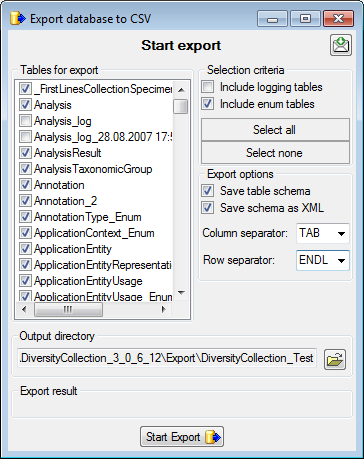
To create a backup of your database on the server, choose Data →

Another option is to create a direct copy of the database files on the server. For this you have to use the functions provided by SQL-Server. However, you need administration rights for the database you want to create a backup of. Open the Enterprise Manager for SQL-Server, choose the database and detach it from the server as shown in the image below.

After detaching the database, you can save a copy of the ..._Data.MDF file to keep it as a backup.
After storing the backup you have to reattach the database.

A dialog will appear where you have to select the original database file in your directory.
The chapter below refers to the module DiversityCollection but is valid for DiversityAgents as well
To export the tables of the database in a tabulator, comma or semicolon separated format, choose Data → Export → Export CSV... from the menu. A window as shown below will open where you can select the tables to be exported in sections Selection criteria and in the Tables for export.
A prerequisite for this export is that the bcp program is installed on your computer. This has either been installed together with the installation of SQL-Server or you have to install the Microsoft Command Line Utilities for SQL Server.

To start the export click on the Start export  button. By default the data will be exported into a directory
...\Export\<database_name> below your application directory. Click
on the
button. By default the data will be exported into a directory
...\Export\<database_name> below your application directory. Click
on the 
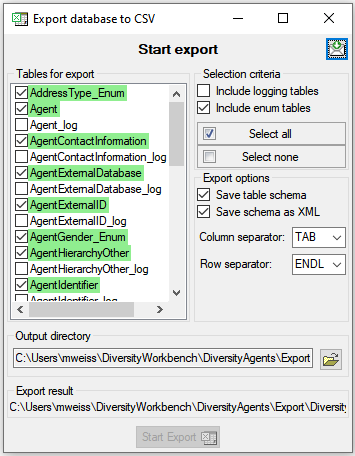
After export the tables are marked with green background, if table schema and data were exported successfully. If only the data were exported, this is marked with yellow background, if nothing was exported, the background is red. A detailed export report can be viewed by a click on the export result file name.



 One parallel table
One parallel table Several parallel tables according to
selected data
Several parallel tables according to
selected data Dependent table
Dependent tableAll options will include the depending tables as defined for the default
table. The 
If you added parallel tables, you should set the sequence of the
datasets within these tables: For the columns that should be used for
sorting the data, set the ordering sequence to a value > 0 and choose
if the ordering sequence should be ascending 

 Certain columns in the database may provide information linked to
another table
Certain columns in the database may provide information linked to
another table 

 button
to add a linked value.
button
to add a linked value.




 on the left side of the column that will change to
on the left side of the column that will change to  for fused columns. To remove a file column, use the
for fused columns. To remove a file column, use the 




 This filter in contrast to the filter above strictly applies to the row
according to the sequence of the data. For an explanation see a short
tutorial
This filter in contrast to the filter above strictly applies to the row
according to the sequence of the data. For an explanation see a short
tutorial





If you want to inspect the SQL commands created during the test check this option. To see the generated SQL click on the SQL button after the Test export. A window containing all commands including their corresponding tables will be shown.






 To export your data into a SQLite
database, choose the
To export your data into a SQLite
database, choose the  Export to SQLite tab. You may change the preset name of the database in order to keep previous exports. Otherwise you overwrite previous exports with the same filename. To start the export, click on the Export data
Export to SQLite tab. You may change the preset name of the database in order to keep previous exports. Otherwise you overwrite previous exports with the same filename. To start the export, click on the Export data
 button. To view the exported data, use the
button. To view the exported data, use the










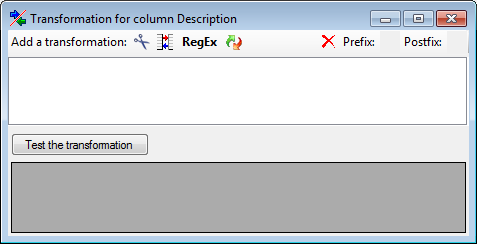
Here you can enter 6 types of transformation that should be applied to
your data. 




With the cut transformation 


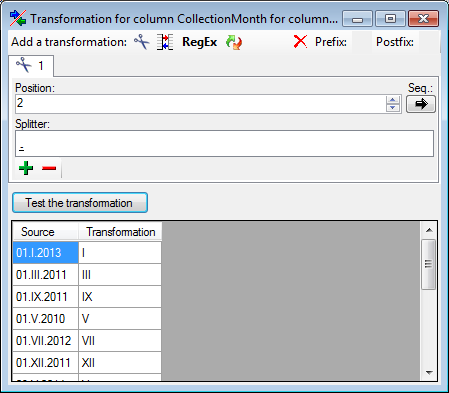
With the Start at Pos. option the given splitters will be converted into space (' ') and the whole string starting with the given position will be used (see below).

The translate transformation 






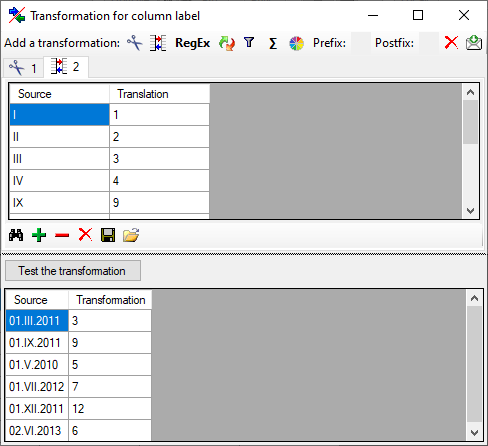
To load a predefined list for the transformation use the


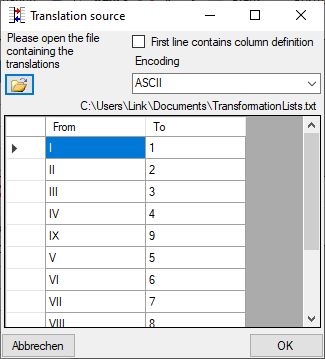
The transformation RegEx using regular expressions will transform the values according to the entered Regular expression and Replace by values. For more details please see documentations about regular expressions.

The replacement transformation 
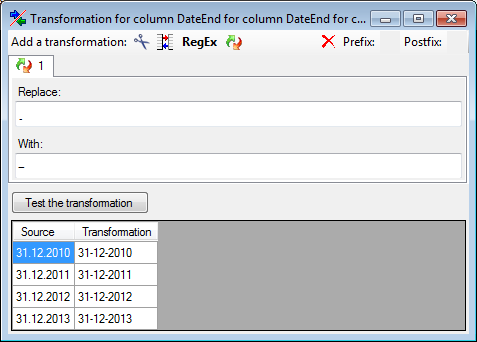
The calculation transformation Σ performs a calculation on numeric value, dependent on an optional condition. In the example below, 2 calculations were applied to convert 2-digit values into 4 digit years.
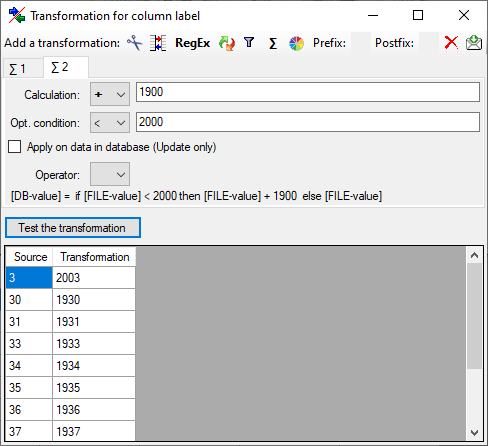
The filter transformation 






This tutorial demonstrates the export of a small sample from the
database. For an introduction see a short tutorial

In the main form, select the data that should be exported (only the data displayed in the query results are exported).
Choose Data → Export → 


In this example, we want to add as many parallel identification tables
as present in the data. To do this, click on the


To set the sequence of the Identifications, select the first table and
for the column IdentificationSequence set sorting sequence to 1 and the
direction for sorting to descending 
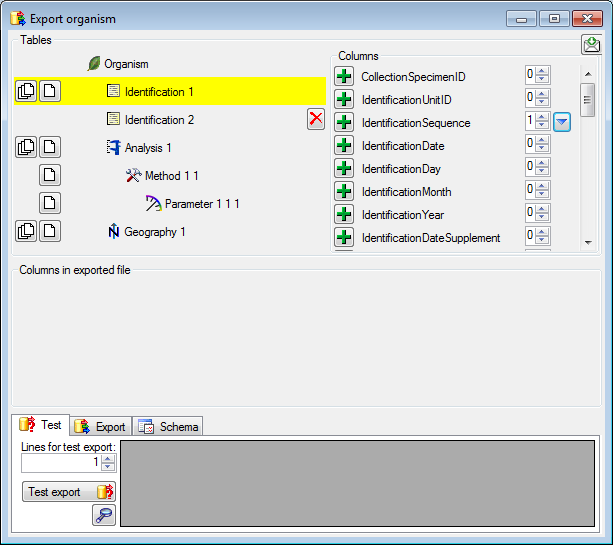
Some columns provide the possibility to add data from linked tables or modules. In this example we choose the column NameURI linking to the module DiversityTaxonNames (see below).

To provide linked values, click on the  button.
A window as shown below will open, where you can choose among the
provided services.
button.
A window as shown below will open, where you can choose among the
provided services.
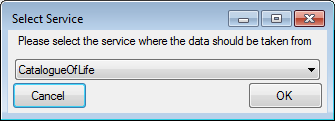
After the service is selected, you will be asked for the value provided by the service (see below).
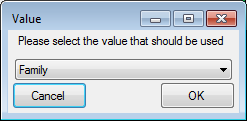
Now the selected link is added underneath the column as shown below. You can add as many links as you need for your export.

For some modules there are values that refer to other modules with a name like [Link to ...] as shown in the example below.

If you select one of theses values, you will be asked to select the service or database linked to this modul (see below)

... and then to select one of the provided columns (see below)

Within the form this linked values will be marked as shown below. If several results are retrieved these will be separated with by " | ".

To add columns to the exported file, click on the 

The families should appear as one column and as the sources can exist
only once for each identification we can fuse these columns. To do so,
click on the delimiters  between these
columns (see below).
between these
columns (see below).

By default the headers for the exported data are set according to the names of the columns in the database. To change this, edit them as shown below where TaxonomicName has been changed to Taxon (see below). For fused columns only the header in the first column will be used.

To test the export, click on the Test export


To finally export the data, choose the 


